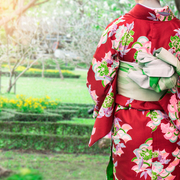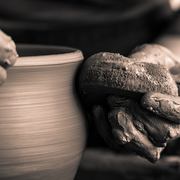Recently, in Japanese summer, it is the very fierce heat.
It is sometimes quite annoying, but, for a long time, we Japanese have thought out the way how we can spend summer comfortably.
Furin (wind chime) is appreciated as one of them.
Let’s walk through charms of Furin, which is a summer tradition in Japan.

What is "Furin"?
Firstly, let’s see the basic information about Furin.
Do you know how Furin rings?
It might be hard to literally explain its details.
Now, we introduce the structure of Furin.
Generally, Furin has three parts.
- Kane (Bell)
- Zetsu (Clapper)
- Tanzaku (A piece of paper)
Zetsu is a small part inside a bell, which is also called “Furikuda”.
Zetsu and Tanzaku are attached by a string.
Tanzaku is hanged from Zestu.
How Furin makes sounds is;
1. Tanzaku catches winds.
2. Zetsu starts moving by influences of Tanzaku.
3. Zetsu hit a bell to make sounds.
Thus, it is very simple.
History of Furin
Then, what kind of history does Furin have?
It is said that Furin came from China*, not originated in Japan.
*There is a theory that it came from India.
Originally, Furin was a tool to tell fortune by the sounds of a bell, placing it hanged from bamboos.
This was called “Senpu-taku”.
This was introduced to Japan at the same time as Buddhism, which came to be called as “Futaku” hanged from a roof of a temple.
Futaku worked as an amulet to protect against bad luck, and it was believed that people living in the area where they can hear the sounds of Futaku would be protected from disasters.
Actually, it has not been clearly explained* how this Futaku with the sense of big presence changed to current small-sized Furin.
*The word “Furin” was introduced by Honen Shonin, the founder of the Jodo Sect (Pure Land Sect).
There was also the record that aristocrats in the Heian and the Kamakura period hung Furin at home as an amulet.
However, by the time of the Edo period(1603-1867), Furin became a tool to enjoy coolness in summer.
Then, Furin was drawn in Ukiyoe, and “Furin Soba”, which refers to Soba noodle seller with Furin on the street stall, got popular and became familiar with ordinary people.

Effects of Furin
Nowadays, you often see various Furin with sophisticated designs.
However, Furin is not only for interior decorations.
Charms of Furin lie in its sounds.
The sounds of Furin has surprising effects.
H ealing Effects
Have you ever heard of the word “1/f fluctuation” before?
In terms of sounds, “1/f fluctuation” means the sounds which processed frequent and infrequent signals.
It is said that human beings feel relaxed with “1/f fluctuation” sounds, which cause α-wave.
For example, babbling of a river and singing of a bird are classified as this.
The sounds of Furin have also this “1/f fluctuation”.
Don’t you feel comfortable somehow with the sounds of Furin?
This has the reason, not only the sense.
E ffects of Cooling down Body Temperature
Furin produces coolness in Japanese summer.
Have you felt somewhat cool with the sounds of Furin hanged in front of the houses in the winds?
This is not because of its atmosphere, as a matter of fact.
Indeed, it is proved that the sounds of Furin cool down the temperature of the body surface 2-3 degrees.
This shows that human brain reacts as follows;
The sounds of Furin → Wind blows → Feel cool
By reacting like this, brain orders peripheral nerves to cool down the body temperature.
This happens only to Japanese.
For foreigners without any connection between the sounds of Furin and coolness in their brains, it is said this does not happen.

Styles of Furin
Now let’s see the styles of Furin.
We introduce some of them among the various styles.
E do Furin
The word of Furin may remind you of glass-made one, first.
Glass-made Furin looks nice and cool, which makes it the representative of Furin.
It became known generally at the end of the Edo period, then it was named as “Edo Furin”.
Edo Furin was made by the technique called “Chu-buki (glassblowing)”, which forms by blowing the glass body heated around 1,320 degrees inside the furnace.
Once the glass gets cooled down, the bottom part of the glass is cut off leaving the edge rough.
This is because a smooth edge cannot produce a sound as Furin.
N anbutestu Furin (Nanbu Furin)
Nanbutetsu Furin (Nanbu Furin) is also famous as Edo Furin.
Nanbutetsu Furin is made from “Nanbu Tekki”, a famous craft in Iwate, as its name shows.
This means that Nanbutetsu Furin is made from high-dense casting with good quality of iron sands.
It makes the difference of its sound.
Unlike ones of Edo Furin, which sounds light, Nanbutetsu Furin echoes high-pitched clear sound.
O dawara Furin
Although it is not as well-known as Edo Furin and Nanbutetsu Furin, Odawara Furin is very popular.
It is the Furin made from Odawara casting, which is a traditional craft in Odawara, Kanagawa, since the Muromachi period.
It is made from Sahari, which is an alloy of copper and tin, and is characterized by its lingering sound.
Akira Kurosawa, the movie director, who was fascinated by its sound, used Odawara Furin in the main scene of the movie “Akahige”.
M yochin-Hibashi Furin
Myochin-Hibashi Furin can be said as an unusual style.
Myochi-Hibashi refers to Hibashi (chopsticks used in a fireplace) produced in Himeji, Hyogo.
Hibashi are metallic chopsticks to pick charcoal.
The Myochin family, the famous armorer, has produced Hibashi with their smiting techniques since the Heian period.
Myochin-Hibashi Furin is made from 4 Hibashi attached by a string to make sounds.
Its sounds are characterized as high-pitched, clear and resonant, which Stevie Wonder praised highly as “the wonder of the East”.
Moreover, Myochin-Hibashi is popular as a gift especially in the Kinki area, where people believe that Hibashi “picks and removes” bad lack.
Because of it, Myochin-Hibashi Furin is also popular as a gift.
Conclusion
These are the basic information and charms of Furin, Japanese summer tradition.
We hope you see the styles of Furin and the special bond with Japanese.
Why don’t you adopt Furin to your summer life?
Let’s explore Furin to find your new partner to ease fierce heat.

















